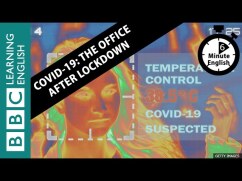COMPLETE TRANSCRIPT
Welcome to English as a Second Language Podcast number 3: Cleaning Up
This is English as a Second Language Podcast episode number three. I’m your
host, Dr. Jeff McQuillan, coming to you from the Center for Educational
Development in beautiful Los Angeles, California.
In this episode, the second of our 10-part special series on daily English, I’ll talk
about getting cleaned up in the morning to go to work.
Let’s get started!
[Start of story]
I go into my bathroom sometime around 6:45 a.m. My sink and medicine cabinet
are on the left when you enter my bathroom. The toilet is next to that, with the tub
in front. Anyway, I turn on the lights, and try to find the mouthwash in the
medicine cabinet. I pour a small amount into a cup, swish it around for 30
seconds, gargle, and spit. Not pleasant, but necessary. Then I get out the floss.
When I’m done flossing, I pull out the toothbrush and the toothpaste. I brush and
then it’s off to the shower.
I pull the shower curtain aside, step into the tub, and pull the curtain back. I turn
on both the hot and the cold water, looking for the perfect temperature. I lather up
with soap, put some shampoo in my hair, then rinse and dry off. Now it’s shaving
time. I used to own an electric razor, but I found it didn’t shave close enough. So
now I’m back to the old hand razor. I lather up with shaving cream, and I start to
shave. I rinse the razor and throw the disposable blades in the trash. It’s about
7:00 AM, and I’m on to breakfast.
[End of story]
In this episode, we are “Cleaning Up,” or making ourselves clean.
“I go into my bathroom,” I begin the story, “sometime around 6:45 a.m.” Notice
that we say a.m., but you could also say “in the morning.” 6:45 is also the same
as quarter to seven. “My sink and medicine cabinet are on the left when you
enter my bathroom.” In your bathroom and in your kitchen there is usually a sink
and a faucet. The faucet “faucet” is where the water comes out, and normally you
have hot water and cold water. The sink is where the water goes into. Usually, it
is a round or a square white bowl, really, that has a hole at the bottom and we
call that hole the drain (drain). That's where the water goes down into the pipe,
it's where the water goes out of the sink. If you want to fill your sink with water,
you usually have to stop the drain. “To stop a drain” means to put something over
it so that the water doesn't go down.
So, we have a faucet and we have a sink, and in your bathroom, you often have
a small box, sometimes with a mirror on it so you can see yourself, that we call
the medicine cabinet. A “cabinet” (cabinet) is like a small box where you put
things, but it's a box that hangs on the wall; it is attached to the wall. You can
have cabinets in your kitchen, where you put your dishes. So, they're containers,
they're things that you used to put and store or keep things.
A medicine cabinet is a place where you have medicine, but also, it's a place
where you put your other things that you use in the bathroom - things like
mouthwash, shaving cream, razors, and so forth. We'll talk about those in a
second. So that's your medicine cabinet.
In my bathroom, the “sink and the medicine cabinet are on the left” side when
you walk into the bathroom; the toilet is next to that. “The toilet” (toilet) is what
you use to go to the bathroom, what you use to get rid of things from your body,
we might say. When you are done using the toilet, you then flush the toilet. The
verb, “to flush” (flush) is when you get rid of what's inside the toilet after you're
done using it, usually with water.
There is a tub in my bathroom. A “tub” (tub) sometimes called a bathtub, is where
you can take a bath. You can fill the tub up with water and you can get into the
water.
“Anyway,” I say in the story, “I turn on the lights.” Notice the use of the word
“anyway.” It's very common in English to use that word when you want to get
back to something you were talking about before. We can also say, “As I was
saying,” it means something similar here.
“Anyway, I turn on the lights, and try to find the mouthwash in the medicine
cabinet.” The “mouthwash” (mouthwash) – all one word – is a liquid like water,
but it has something in it that helps clean your teeth, clean the inside of your
mouth; that is mouthwash. So, you take the mouthwash and you “pour a small
amount into a cup.” The mouthwash usually comes in, or is in, a bottle. This
bottle, you take and you pour some mouthwash into a cup. To pour means to
take something that is liquid, like water or mouthwash, and put it somewhere
else. In this case, it's into a small cup.
After I put it into the cup, I “swish it around for 30 seconds.” “To swish (swish)
something around” means to move it around, and we use that verb usually when
talking about something that is liquid like water or mouthwash that you move
back and forth very quickly. So, when you put the mouthwash in your mouth,
usually you take your sides of your mouth, what we would call your “cheeks”
(cheeks), your cheeks, and you move them back and forth, so that the
mouthwash covers and cleans all of your teeth.
After “I swish it around,” I “gargle.” The verb “to gargle (gargle) means to take
water and to put it into your back of your mouth. I will have to demonstrate this.
It's easier to understand if you can hear it. [Gargling sound] That's to gargle.
That's just an extra little bonus for listening to this episode; you get to hear me
gargle!
Well, after I gargle, I have to get rid of or remove the water from my mouth, and I
do that by spitting. “To spit” (spit) means to take something that's liquid, like
water, and to remove it from your mouth. Usually, you make a certain sound like
[spitting sound] - something like that.
Well, now we've gargled and spit. I say these are “Not pleasant, but necessary,”
not necessarily something nice but something I have to do. After I use the
mouthwash, “Then I get out,” or take out, the floss. “Floss” (floss) is a piece of
string that you put in between your teeth to clean; we call that floss. And there's a
verb, “to floss,” which means to use that little piece of string.
“When I’m done flossing,” when I have finished flossing, “I pull out,” or take out,
“the toothbrush and the toothpaste.” The toothbrush is what you use to clean
your teeth; the toothpaste is like the soap that you use to clean your teeth. But,
we do not call it tooth soap. We call it toothpaste. It comes in a container that we
call a “tube,” and the tube (tube) is where the toothpaste is, and you usually
squeeze the tube (squeeze) to get the toothpaste out of the tube.
So, I put some toothpaste on my toothbrush and then I brush. We use that verb,
“to brush,” to mean to clean my teeth. But, we don't say, “I'm going to clean my
teeth.” Usually we say, “I'm going to brush my teeth.” That same verb, “to brush,”
can also be used with your hair, when you are trying to put your hair in a certain
place, a certain position. I don't brush my hair, of course, because I don't have
any hair, but I used to, when I was younger, brush my hair.
I finished brushing my teeth, so now I'm going to take a shower. There's a
difference between taking a shower, where the water comes from the top of the
wall and goes over you, and a bath, which means to fill your bathtub with water
and get in. Most American homes have the tub and the shower in one place.
Some homes have a separate shower and a separate tub.
In the story, I say that “I pull the shower curtain aside.” The “curtain” (curtain) is
what you use to keep the water in the shower from going onto the floor. It
prevents the water from leaving the shower area. We use that word, “curtain,”
also for the things that you can put over your window in your house or apartment,
so nobody can see inside; that's also called a curtain.
Well, “I pull the shower curtain aside,” meaning I put it to one side, the left side or
the right side. I “step into the tub, and I pull the curtain back,” I put it back in its
original position. “I turn on both the hot and the cold water.” “To turn on” means
that I turn the faucet on so that the water comes out. Remember, the faucet is
where water comes out for a sink; it's also where the water comes out for a tub or
a shower. Actually, for the shower, the top of the shower, we don't normally call
that a faucet; we call that a showerhead (head). So, the showerhead is where the
water comes out when you're taking a shower. And, if you are drawing a bath,
meaning if you are putting water into your tub to take a bath—to draw a bath—
then you use the faucet. The water comes out of the faucet spout (spout). That's
the part of the faucet where the water actually comes out of.
I step into the shower, I turn on “the hot and cold water, looking for the perfect
temperature,” not too hot, not too cold. “I lather up with soap.” “To lather” (lather)
or to “lather up” means to take soap and put it on your skin and then put water on
it, and you rub the soap and the water together until you make little bubbles, until
the soap and water covers your skin. That is to lather or to lather up.
Well, “I lather up with” some “soap,” and then I “put some shampoo in my hair.”
“Shampoo” (shampoo) is the soap for your head, for your hair, if you have hair.
So, you take this special soap, usually it is a liquid soap, and you put it on your
hair and that is called shampoo. You can also lather up your shampoo. You take
your hands and you move them back and forth quickly, and that would lather up
your shampoo.
Well, after you do that, then you have to get rid of the soap and the shampoo,
and you do that by rinsing. “To rinse” (rinse) means to take water and get rid of
the soap and the shampoo that are on your body. After you do that, then you
have to dry your body off. “To dry off” means the same as to dry, but we use that
expression, “to dry off,” to mean to dry, in this case, your body with a towel.
Now, it is time for me to shave. “To shave” (shave) means to remove hair, usually
from your face. If you are a man and you don't shave, you will grow a beard and
a mustache; you will have hair on your face. Well, I don't like beards and
mustaches, so I shave - I use something to get rid of the hair.
The thing I use to get rid of the hair is the “razor” (razor). A razor is like a knife. It
has a blade (blade) and the blade is the thing that actually cuts the hair, that
removes the hair. So, you have a razor that you use to shave the whiskers from
your face. A “whisker” (whisker) is the name we give the hair on your face, at
least for a man, we call those whiskers. So, you can have an electric razor, like I
used to have, or you can have a hand razor. A hand razor is one that is not
electric that you just take and you shave by moving the razor back and forth on
your face.
Before I shave, I have to “lather up with shaving cream.” We already know that
word “lather up” – it means to mix the soap with water and make bubbles so that
it spreads across your skin. “Shaving cream” (cream) is the special kind of soap
or special kind of liquid material that you put on your face to make it easier for
you to shave, so you don't cut yourself or hurt yourself when you are shaving.
“I rinse the razor” after I am done shaving, and I “throw the disposable blades in
the trash.” The blades are the things that go on top of the razor that cut the
whiskers, or remove the whiskers. “Disposable” (disposable) comes from the
verb “to dispose” (dispose), which means to throw away, to put in the trash, to
put in the garbage. That is disposable. If something is disposable, you use it
once or twice and then you throw it away. Well, these are disposable blades.
Now it's seven o'clock when I finish showering and shaving, and I am “on to
breakfast,” meaning now I am going to have my breakfast.
Let's listen to the story again, this time at a native rate of speech.
[Start of story]
I go into my bathroom sometime around 6:45 a.m. My sink and medicine cabinet
are on the left when you enter my bathroom. The toilet is next to that, with the tub
in front. Anyway, I turn on the lights, and try to find the mouthwash in the
medicine cabinet. I pour a small amount into a cup, swish it around for 30
seconds, gargle, and spit. Not pleasant, but necessary. Then I get out the floss.
When I’m done flossing, I pull out the toothbrush and the toothpaste. I brush and
then it’s off to the shower.
I pull the shower curtain aside, step into the tub, and pull the curtain back. I turn
on both the hot and the cold water, looking for the perfect temperature. I lather up
with soap, put some shampoo in my hair, then rinse and dry off. Now it’s shaving
time. I used to own an electric razor, but I found it didn’t shave close enough. So
now I’m back to the old hand razor. I lather up with shaving cream, and I start to
shave. I rinse the razor and throw the disposable blades in the trash. It’s about
7:00 AM, and I’m on to breakfast.
[End of story]
Her scripts are always pleasant. I speak, of course, of our wonderful scriptwriter,
Dr. Lucy Tse. Thank you, Lucy!
From Los Angeles, California, I’m Jeff McQuillan, thank you for listening. Come
back and listen to us again right here on ESL Podcast.
GLOSSARY
sink – a kitchen or bathroom container that is attached to the floor and wall,
holds water, and is used for washing dishes or brushing teeth
When Lily came home, she was disappointed to see that the sink was full of*
dirty dishes.
medicine cabinet – a small, flat cabinet on a bathroom wall that is used to store
medicines, toothbrushes, lotions, and other things, and has a mirror on front
If you have a headache, take an aspirin. There’re in the medicine cabinet*
toilet – a large bowl and pipe attached to the floor and wall in a bathroom, used
to collect body waste
Cleaning the toilet is my least favorite household chore*
tub (also bathtub) – a large, long container that you fill with water and then sit in
to take a bath
Marsha relaxes by filling her tub with hot water and taking a bath while listening*
to classical music.
mouthwash – a liquid that cleans one’s mouth and makes breath smell better
After eating foods with strong flavors like garlic and onion, you should use*
mouthwash because it covers the smell.
to swish (something) around – to quickly move a liquid around the inside of
one’s mouth without drinking it
The dentist said that I should swish mouthwash around for at least 30 seconds*
every morning.
to gargle – to move a liquid into the back of one’s throat without drinking it.
Harry believes that the best cure for a sore throat is to gargle warm water with*
lemon juice and salt.
to spit – to push food or liquid out of one’s mouth
When Jack was six years old, he had trouble taking medicine. He didn’t like the*
taste and would spit it out.
floss – a thread that is moved between teeth to clean them
A toothbrush cleans the front and back of your teeth, but only dental floss can*
clean between teeth.
shower curtain – a large piece of plastic or cloth that hangs from the ceiling to
the floor in front of a bathtub or shower to keep water from entering the rest of
the room
This morning Uncle Kenny forgot to close the shower curtain, so there was*
water all over the floor.
to lather up – to cover oneself with soap or one’s hair with shampoo
We ran out of hot water immediately after I lathered up, so I had to wash off the*
soap in cold water!
shampoo – liquid soap made for cleaning hair
People with long hair use more shampoo than people with short hair do*
to rinse off – to use water to remove soap from something
Kelly’s son cried when she rinsed him off because she accidentally got soap in*
his eyes.
to shave – to remove hair from the body by using a razor that cuts the hair near
the skin
In the United States, many women shave their legs to make them look*
smoother.
electric razor – an electronic device for shaving
When I was a child, I always woke up to the sound of my father using an*
electric razor to shave his face.
hand razor – a plastic or metal tool for shaving, held in one’s hand
When he started shaving, he often has cuts on his chin because he didn’t know*
how to use a hand razor.
shaving cream – a cream, foam, or lotion that is put on the skin before shaving
If I shave without shaving cream, my skin becomes red and itchy*
disposable blades – the flat, sharp piece of metal in a hand razor that cuts the
hair and can be thrown out and replaced
Disposable blades are more expensive than traditional blades but they never*
need to be re-sharpened









